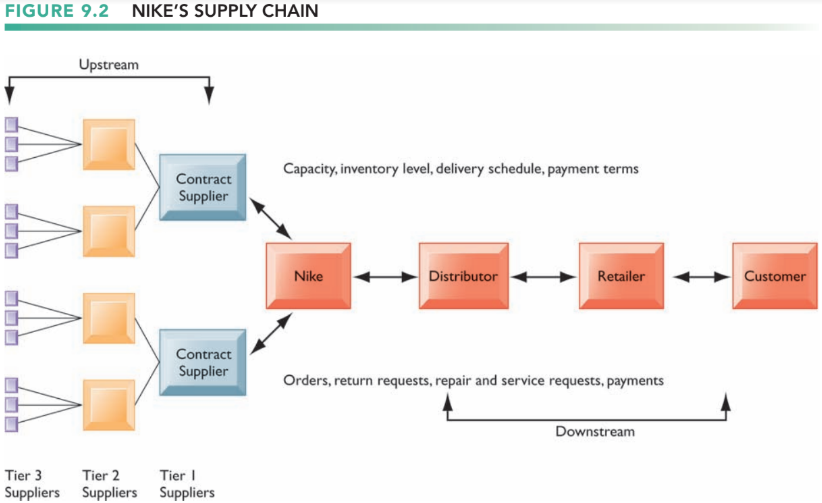15.1.1: The Supply Chain
A firm’s supply chain is a network of organizations and business processes for procuring raw materials, transforming these materials into intermediate and finished products, and distributing the finished products to customers. It links suppliers, manufacturing plants, distribution centers, retail outlets, and customers to supply goods and services from the source through consumption. Materials, information, and payments flow through the supply chain in both directions.
Goods start out as raw materials and, as they move through the supply chain, are transformed into intermediate products (also referred to as components or parts) and, finally, into finished products. The finished products are shipped to distribution centers and from there to retailers and customers. Returned items flow in the reverse direction from the buyer back to the seller.
Let’s look at the supply chain for Nike sneakers as an example. Nike designs, markets, and sells sneakers, socks, athletic clothing, and accessories throughout the world. Its primary suppliers are contract manufacturers with factories in China, Thailand, Indonesia, Brazil, and other countries. These companies fashion Nike’s finished products.
Nike’s contract suppliers do not manufacture sneakers from scratch. They obtain components for the sneakers—the laces, eyelets, uppers, and soles—from other suppliers and then assemble them into finished sneakers. These suppliers in turn have their own suppliers. For example, the suppliers of soles have suppliers for synthetic rubber, suppliers for chemicals used to melt the rubber for molding, and suppliers for the molds into which to pour the rubber. Suppliers of laces have suppliers for their thread, for dyes, and for the plastic lace tips. tips.
Figure 9. 2 provides a simplified illustration of Nike’s supply chain for sneakers; it shows the flow of information and materials among suppliers, Nike, Nike’s distributors, retailers, and customers. Nike’s contract manufacturers are its primary suppliers. The suppliers of soles, eyelets, uppers, and laces are the secondary (Tier 2), suppliers. Suppliers to these suppliers are the tertiary (Tier 3), suppliers.
The upstream portion of the supply chain includes the company’s suppliers, the suppliers’ suppliers, and the processes for managing relationships with them. The downstream portion consists of the organizations and processes for distributing and delivering products to the final customers. Companies that manufacture, such as Nike’s contract suppliers of sneakers, also manage their own internal supply chain processes for transforming materials, components, and services their suppliers furnish into finished products or intermediate products (components or parts) for their customers and for managing materials and inventory.
The supply chain illustrated in Figure 9. 2has been simplified. It only shows two contract manufacturers for sneakers and only the upstream supply chain for sneaker soles. Nike has hundreds of contract manufacturers turning out finished sneakers, socks, and athletic clothing, each with its own set of suppliers. The upstream portion of Nike’s supply chain actually comprises thousands of entities. Nike also has numerous distributors and many thousands of retail stores where its shoes are sold, so the downstream portion of its supply chain is also large and complex.

